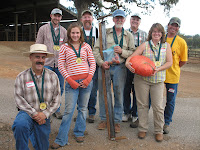
My border collie, Taff, is my pal. While he would be happy just hanging out with me all day every day, he's happiest on the days he gets to work. He's one of the most loyal canine friends I've ever had.
We've had Taff for almost 2 years. We purchased him through our friend Ellen Skillings, who is an amazing handler and breeder of border collies. While Taff was not a successful sheep dog trial dog, the attributes that contributed to this lack of success have made him a wonderful farm dog. I couldn't imagine managing sheep and cows without him now!
When Taff first came to live with us, he was very stand-offish with the rest of my family. He followed me everywhere, but he wouldn't work for anyone else. As he's realized that he's here to stay, he's bonded with everyone (especially our youngest daughter, Emma). He'll work for other members of our family now, too.
Taff has helped me realize that the "mistakes" he makes are generally mine - I get in a hurry or I'm not clear with my instructions to him. He's helped me become a better stockman. This has also improved my mulemanship skills - I've realized that any breakdown in communication with my animals (canine or equine) is generally my fault.
Taff follows me from room to room when he's in the house. He sleeps inside (when he's clean enough) - always by my side of the bed. When he first came to live here, he'd chew on my shoes if I didn't take him with me everyday.
Some say that owners look like their dogs and vice versa. In our case, I'm not sure the physical resemblance is there. However, Taff often seems unkempt, and he generally smells like he's been working. My family says the same about me!
We've had Taff for almost 2 years. We purchased him through our friend Ellen Skillings, who is an amazing handler and breeder of border collies. While Taff was not a successful sheep dog trial dog, the attributes that contributed to this lack of success have made him a wonderful farm dog. I couldn't imagine managing sheep and cows without him now!
When Taff first came to live with us, he was very stand-offish with the rest of my family. He followed me everywhere, but he wouldn't work for anyone else. As he's realized that he's here to stay, he's bonded with everyone (especially our youngest daughter, Emma). He'll work for other members of our family now, too.
Taff has helped me realize that the "mistakes" he makes are generally mine - I get in a hurry or I'm not clear with my instructions to him. He's helped me become a better stockman. This has also improved my mulemanship skills - I've realized that any breakdown in communication with my animals (canine or equine) is generally my fault.
Taff follows me from room to room when he's in the house. He sleeps inside (when he's clean enough) - always by my side of the bed. When he first came to live here, he'd chew on my shoes if I didn't take him with me everyday.
Some say that owners look like their dogs and vice versa. In our case, I'm not sure the physical resemblance is there. However, Taff often seems unkempt, and he generally smells like he's been working. My family says the same about me!












